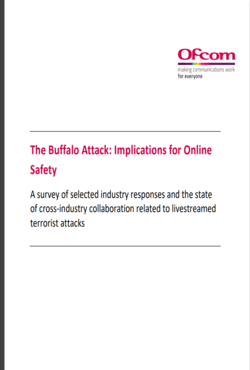The Buffalo Attack: Implications for Online Safety
By Ofcom
On 14 May 2022, an attack was carried out in Buffalo, New York, which resulted in the death of ten individuals and the wounding of three others. The attack was live-streamed online and versions of the footage were disseminated on multiple online services, potentially exposing UK users to content related to terrorism. As the regulator of UK established video-sharing platforms (VSPs) and the prospective UK Online Safety regulator, we sought to learn from the tragic event by reviewing industry responses to the live-streamed attack and cross-industry collaboration to prevent dissemination of associated content. The Buffalo attack showed that terrorist, violent and hateful content online can play a significant role in radicalising vulnerable users. The attacker was reportedly inspired by, and used a similar modus operandi to, the Christchurch mosque attacks in New Zealand, where 51 individuals lost their lives. Large sections of the Christchurch attacker’s manifesto were copied and numerous references were made to him in the Buffalo attacker’s diary. Such an attack highlights the complexity and challenges associated with terrorist content online. It has been reported that the attacker was radicalised in part through exposure to racist content on the message board 4chan. He also appears to have acted alone and did not belong to any terrorist or other related organisation. Links to his online diary were shared in private servers and through direct messages approximately 30 minutes before the attack; 15 individuals clicked on the link to the diary. The livestream of the attack lasted less than 2 minutes and there were 28 viewers, or fewer, who watched the livestream of the channel at some point during broadcast. Despite this low figure, footage of the attack was spread across platforms and seen by millions of people, and copies of the diary and manifesto were shared mainly through smaller platforms. The potential of harm from such an exploitation of online services is multifaceted: the disturbing and graphic nature of the footage, the (re)traumatisation of communities who have been affected by similar incidents and the risk of radicalisation of vulnerable online users.
London: Ofcom, 2022. 32p.


